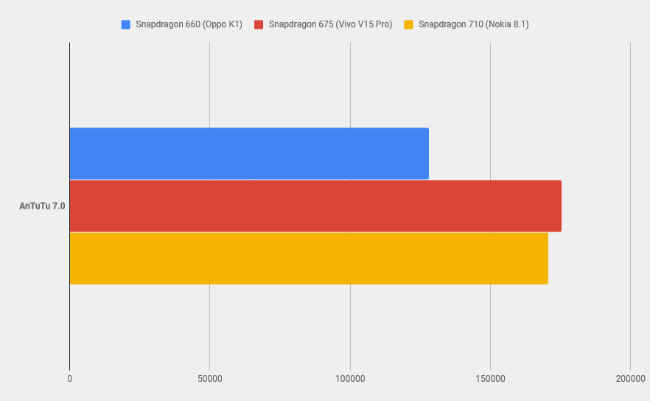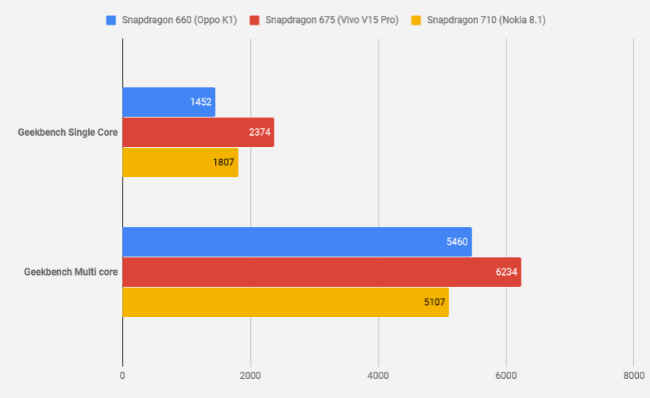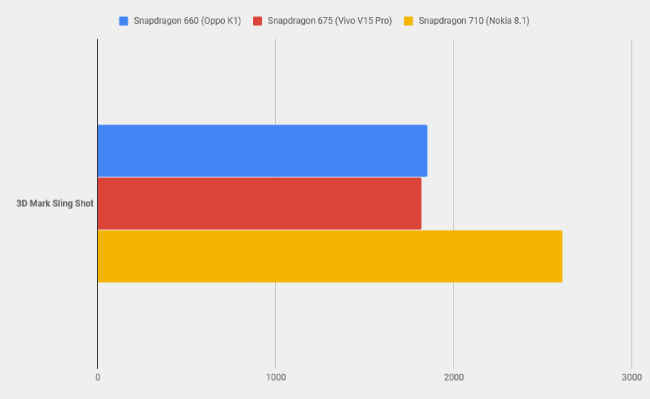Vivo V15 Pro vs Oppo K1 vs Nokia 8.1: Snapdragon mid-range performance showdown
The Snapdragon 675 that debuted with the Vivo V15 Pro offers a big jump in performance as compared to the Snapdragon 660, sometimes even thwarting the Snapdragon 710 in performance tests.

The Snapdragon 6-series used to rule the roost in the mid-range segment, til lthe Snapdragon 7-series came along with the aim to bridge the gap between mid-range SoCs and the flagship offerings. As a result, the choice becomes even more difficult these days. Should you stick to a 6-series processor or a 7-series one, now that the chipsets are available at more or less the same price. So we took some of the early instances where the Snapdragon 675, the Snapdragon 660 and the Snapdragon 710 popped up in India and studied how they compare in terms of raw performance. If you were in the market for a mid-range smartphone, this will help you make the choice easier. We took the Vivo V15 Pro, the Oppo K1 and the Nokia 8.1 to compare the performance.
 Survey
SurveyWith the Qualcomm Snapdragon 675 debuting on the Vivo V15 Pro in India, we take this opportunity to study the improvements in the Snapdragon 675 and see how it fares with relation to the older Snapdragon 660 and the ‘higher’-end Snapdragon 710. The Snapdragon 675 is also expected to power the upcoming Xiaomi Redmi Note 7 Pro that will reportedly sport the 48MP flagship Sony IMX586 sensor.
Before diving into the performance numbers, let’s take a look at the specs of the three chipsets.
Qualcomm Snapdragon 675 vs Qualcomm Snapdragon 660 vs Qualcomm Snapdragon 710 specs
On paper, the Qualcomm Snapdragon 675 is definitely a marked improvement over the Snapdragon 660. It even trumps the Snapdragon 710 in certain aspects, but overall the Snapdragon 710 remains a cut above the 6-series chipsets. The most crucial improvement is in the CPU itself. The Snapdragon 675 uses a more powerful custom Kryo core and is made on a smaller manufacturing process as compared to the Snapdragon 660. The Snapdragon 675 uses the latest ARM Cortex-A76 cores for high-performance which is the first time Qualcomm has used the latest ARM cores in a mid-range segment. The Snapdragon 710 is even more advanced, being manufactured on a 10nm platform.
The bigger difference is in the ISP. This is where the Snapdragon 675 trumps the Snapdragon 710. The Snapdragon 710 comes with two 14-bit Qualcomm Spectra 250 ISP while the Snapdragon 675 houses two 14-bit Spectra 250L ISP which has support for up to 48MP cameras.
Furthermore, the Snapdragon 675 comes with an Adreno 612 GPU as compared to the Adreno 512 on the Snapdragon 660. Qualcomm claims gaming and graphics rendering on the Snapdragon 675 is improved. Qualcomm also reportedly worked with popular game engines like Unity and Unreal Engine 4 to make games run better on the platform. There’s support for Vulkan APIs and OpenGL 3.2. Qualcomm promises over 90 percent lesser janks while gaming, which is done via Huawei’s GPU-Turbo-like in-game optimisations which are restricted to specific gaming titles.
The Snapdragon 710, however, has no such gaming enhancements. It does have a slightly more powerful Adreno 616 GPU, but Qualcomm’s aim with this SoC is to improve power-efficiency. The chip is manufactured on a 10nm LPP process and promises up to 40 percent power efficiency in gaming.
Finally, the Snapdragon 675 supports the latest fast charging standard — Quick Charge 4+ that debuted with the Snapdragon 855 while the other two are still at Quick Charge 4.
Now, let’s get into how we tested the performance of the chips.
Testing Performance
To test the performance, we ran our suite of performance-intensive benchmark apps and compared the scores and calculated the percentage change.
Apps we used to test:
- AnTuTu 7
- Geekbench Single Core
- Geekbench Multi-Core
- 3DMark Slingshot
- GFXBench
- PCMark
- Gamebench
- AI Mark
Furthermore, we tried to push the phones to their limits running graphics-intensive games — PUBG Mobile and Asphalt 9. We recorded the performance of the phone during the game using Gamebench where we record a multitude of metrics, including the median FPS the game runs at and the FPS stability percentage to compare.
Note: The Snapdragon 675-powered Vivo V15 Pro could not run GameBench both in desktop mode and web mode. We presume it’s because Gamebench has not formally opened up support for the Snapdragon 675. We have reached out to the developer and hope to update the piece with Gamebench data for the Vivo V15 Pro soon.
Finally, we used the unlisted version of 3DMark to see if there’s anything fishy going on under the hood. If the results show a marked difference from the official scores, we have reason to suspect the smartphone is using undisclosed means to boost benchmark scores.
CPU Performance
The table below notes the scores of synthetic benchmark apps we use to test smartphone performance. We ran the tests on the Vivo V15 Pro, Oppo K1 and the Nokia 8.1.
The results show the Snapdragon 675-powered Vivo V15 Pro has the highest scores on AnTuTu and Geekbench. While there is a good 27 percent improvement in AnTuTu scores over the Snapdragon 660, it’s also slightly higher than the Snapdragon 710’s score by around 2.5 percent. On Geekbench's Single and Multi Core benchmarks, the Snapdragon 675 is 38 percent and 12 percent faster respectively, as compared to the Snapdragon 660. It’s also faster than the Snapdragon 710-powered Nokia 8.1 by 23 percent and 18 percent respectively. Interestingly, the multi-core performance of the Snapdragon 710 was lower than the Snapdragon 660, which could be a result of poor optimisation.
The synthetic benchmark results are corroborated by Mobile Xprt’s scores which simulates real-world performance by performing commonl tasks. Most tasks were completed faster by the Vivo V15 Pro, followed by the Snapdragon 710 and then the Snapdragon 660.
Even PCMark’s Work 2.0 while also runs a suite of real-world tasks pegged the Snapdragon 675 higher than the other two.
GPU Performance
In terms of the GPU performance, the Snapdragon 710-powered Nokia 8.1 is far ahead. But that’s primarily because the Snapdragon 710 uses a more powerful Adreno 616 GPU as compared to the Adreno 612 GPU. The benchmark scores put the Nokia 8.1 on top, followed by the Snapdragon 675 and then the Snapdragon 660.
However, there were some interesting discrepancies. The Snapdragon 675, Qualcomm claimed is specially tuned for gaming and graphics-intensive tasks. It even houses a more powerful Adreno 612 GPU as compared to the Adreno 512 on the Snapdragon 660. But on 3DMark Slingshot, the Vivo V15 Pro actually scored lower than the Oppo K1. The Oppo K1 scored 1850 while the Vivo V15 Pro’s score was a little lower at 1817.
That was quickly refuted by the GFXBench tests which renders high-definition graphics and measures the number of frames the GPU is able to render in a given period of time. The results show the Nokia 8.1 powered the Snapdragon 710 outgun the rest, but more interestingly, Qualcomm’s claims of a superior GPU holds up in the Snapdragon 675 as compared to the Snapdragon 660.
Even the AI performance of the Snapdragon 675 has improved. It’s nearly the same as the Snapdragon 710, showing the rapid progress Qualcomm made in AI computing. When compared to the Snapdragon 660-powered Oppo K1, the Vivo V15 Pro with Snapdragon 675 is a whopping 53 percent faster.
Gaming
While most of our tests rely on pre-packaged synthetic benchmark apps, gaming with the smartphone gives us a good idea of how the peak performance fares among rivals. To test gaming performance, we played Asphalt 9 and PUBG Mobile, both highly-demanding games with high-popularity. We used Gamebench to record the gameplay metrics like median FPS and FPS stability.
Unfortunately, the Vivo V15 Pro did not run GameBench, and as a result, we don’t have numeric data for the phone’s gaming performance. However, we did draw some anecdotal conclusions after using the phone to play the above-mentioned games.
The table below shows the gameplay metrics —
The Snapdragon 660-powered Oppo K1 might not offer flagship-grade performance, but it’s at par with most other mid-range chips we tested using Gamebench. On Asphalt 9, the Oppo K1 offered 28 frames per second with 85 percent FPS stability, while on PUBG Mobile, the Oppo K1 offered a higher 29 FPS with 80 percent stability. The Snapdragon 660 was already ahead of its peers from last year in terms of gaming performance.
Interestingly, the Qualcomm Snapdragon 710-powered Nokia 8.1 also offered similar performance numbers on Asphalt 9. The phone gave 29 FPS with a higher 88 percent stability, proving the Adreno 616’s might. On PUBG Mobile, the Nokia 8.1 gave a good 30FPS but with an even better 94 percent stability. Clearly, the Snapdragon 710 is a good chipset for gaming.
The Vivo V15 Pro powered by the Qualcomm Snapdragon 675 also showed remarkable improvement in gaming. While we don’t have the numeric data to objectively represent the improvement, it’s still noticeable while playing the game. Immediately while setting up, the game states you can play in high graphics settings, as compared to medium on the Snapdragon 660-powered Oppo K1. The gameplay itself is noticeably smoother than the Oppo K1, but more or less the same experience as the Snapdragon 710. The textures were a little richer on the Nokia 8.1, but I’m guessing that’s also because of the company’s PureDisplay aiding the contrast levels. While we couldn’t objectively verify how fast the Snapdragon 675 is in terms of gaming, it did show a noticeable improvement, and for now, that will have to suffice.
We will revisit this section once again once the Vivo V15 Pro is supported by Gamebench.
Cheating on benchmarks?
While we rely on synthetic benchmark numbers to determine the performance of smartphone SoCs, there remains a dangling doubt over what the number represents ever since a string of manufacturers including Huawei, Realme, Oppo and even OnePlus tried to manipulate the scores using unscrupulous means. To eliminate any such possibilities, we sourced an unlisted version of 3DMark to see if there’s a significant difference in the scores from the official 3DMark app and the unlisted version.
Here are the results —
We only consider the device to be cheating on benchmarks if the numbers from the listed version of 3DMark are higher than the unlisted version by 5 percent or more. In case the scores from the listed version are lower than the unlisted one, the results do warrant further investigation. In this case, while there is some difference in the scores, they aren’t high enough to consider the phones to be manipulating the benchmark scores. In case of the three phones, the variance never went over 3 percent, which is normal.
In Conclusion
The Snapdragon 675 is noticeably improved mid-range chipset as compared to its predecessor, the Snapdragon 660. The Snapdragon 660 set a benchmark in the mid-range segment with devices like the Realme 2 Pro, Asus Zenfone Max Pro M2 and the likes. The chipset’s performance was reason enough for us to recommend the two phones. There’s also the Huawei HiSilicon Kirin 710 SoC that’s being offered in the same price range. It barely meets up to the Snapdragon 660, and based on what we saw, the Snapdragon 675 is likely to blow away the competition in the mid-range segment. The Snapdragon 675 also comes dangerously close to beating the Snapdragon 710 as seen in our tests. With the Snapdragon 710 being positioned as a high-tier SoC while the Snapdragon 675 is set to replace the Snapdragon 660 in the mid-range (under 20k) segment, does it really make sense to go for the more expensive Snapdragon 710?
The Vivo V15 Pro obviously isn’t a mid-ranger, despite having the Snapdragon 675 powering it. It offers features like a pop-up selfie camera, triple rear cameras and a bezel-less AMOLED display with an in-display fingerprint sensor. All that automatically increases the premium. However, the same Snapdragon 675 is expected to power the upcoming Xiaomi Redmi Note 7 Pro that’s set to launch this week on February 28th.







